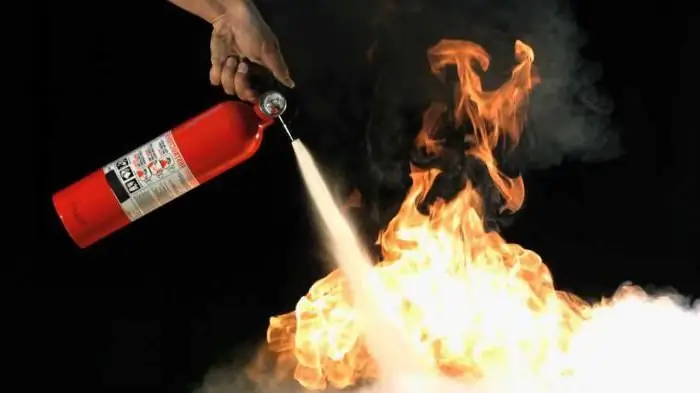2026 Author: Howard Calhoun | [email protected]. Last modified: 2025-01-24 13:10:31
Among the huge variety of primary fire extinguishing agents, one of the cheapest and at the same time highly effective fire-fighting cloth (felt mat), made of dense non-flammable fabric.
Purpose of the fireproof cloth

The main task of fire-fighting fabric (felt mats) is to block fire at the initial stage. Throwing the canvas over a flaming object, you can stop the access of oxygen, bring down the flame and thereby create a fireproof barrier. Several fires can be put out with a non-flammable cloth, unlike fire extinguishers, which require recharging after use. The canvas is used until it becomes unusable. They often protect structures and objects (tanks with flammable liquids, gas cylinders) from thermal radiation and sparks during work with fire.
Properties
The canvas is a rectangular piece of durable fabric made of heat-resistant non-flammable material (fiberglass). The area of the canvas is three square meters. Its weight does not exceed a kilogram. The felt is placed in specialcovers that allow you to remove the canvas quickly enough (in five seconds). Depending on the model (PP-300, 600, 1000, 1200), the fabric must withstand temperatures from minus forty to plus a thousand degrees. At temperatures from -40 to +50 degrees Celsius, its shelf life is more than three years. The total service life should not exceed 7 years.
All kinds of materials from which the felt mat is made perfectly cope with the function of high-temperature insulation.

In the past, when there were no modern means for extinguishing a fire, felt felt was made from felted camel or sheep wool, and to make it fire resistant, it was impregnated with a clay mixture.
Today, in addition to the fire-fighting felt-type felt mat, a fabric made from various types of silica fabrics is used, which perfectly perform the function of high-temperature insulation. Such fabrics include fiberglass, fire-resistant tarpaulins, or asbestos (mountain flax). They are coated with a special solution containing polysaccharides, gum arabic, guar gum, agar and other substances.
Stop the spread of fire and save lives thanks to its excellent refractory characteristics.
Location
In order for the canvas to be easily found, quickly removed and used, it must be located in a visible and accessible place. The felt mat should be located on fire shields (type ShchP-SKh, ShchP-V, ShchP-E), as it is part of the firetools. Also canvases are equipped with mobile fire stands and shields. Often, fire blankets are found in cars, vehicles carrying flammable liquids and gases, in chemical laboratories, in workshops and workshops.
Terms of Use

Like any other fire equipment, the felt mat can only be used for its intended purpose. The canvas must be removed from the bag-cover, straightened and taken in such a way by the handles so that it is placed between the person who carries out the extinguishing and the fire. Further movement away from you should cover the hearth. The source of ignition must be approached only from the windward side. When it is not possible to cover it, one should try to put out the flames with a felt mat.
Each time the canvas is inspected for damage in the form of tears or burnt areas. Damaged fabric cannot be reused. Also, after extinguishing flammable liquids and oily substances, it is forbidden to reuse the felt, because chemicals can be absorbed into the fabric.
Scope of application

According to the current rules, a fire blanket is used to extinguish fires of various classes. Namely:
- class A - burning materials that have combustible properties in the solid state;
- class B - materials that have combustible properties burn in a liquid state;
- class C and E - burning electrical equipment under highvoltage.
Benefits
Fireproof felt has a lot of advantages. Its main benefits include:
- Due to the absence of carcinogenic substances, there is no detrimental effect on he alth when used.
- When exposed to high temperatures, the felt is resistant to shrinkage, does not conduct electricity.
- Highly resistant to aggressive environments (corrosion, decay, microorganisms, s alty sea water), wear-resistant. Once bought, a painting will last for years.
- Efficiency is high, although the cost is relatively small.
Flaws

As such, the fire blanket has no disadvantages. The only thing you need to pay attention to is the correctness of the way it is applied.
Working conditions
It is forbidden in places where fire mats are stored, to use open fire, chemically hazardous substances, fuels and lubricants. When the limit state of the canvas comes (the handles are damaged and there are visible tears), it is also forbidden to use it.
Recommended:
Hoskold method, Ring method, Inwood method - ways to recover investment capital

When a person invests his own money in an income-generating object, he expects not only to receive profit from the invested capital, but also to fully repay it. This can be done through resale or by obtaining such profits that not only bring interest, but also gradually return investments
Fire fighting. Automatic fire extinguishing system

Fire has been used by people since ancient times, but it is not always possible to contain it within a limited framework. But the flame is considered an element, which is sometimes difficult to stop. To ensure safety, an automatic fire extinguishing system is used. At the same time, there are several types of such equipment, which have their own characteristics
Fire alarm and fire extinguishing installation

The article is devoted to the fire alarm and fire extinguishing system. The technologies for installing the main components of such systems are considered
The fire column is an important part of the fire extinguishing system

To extinguish fires, you need access to the nearest water supply network, in a modern fire-fighting system it is provided by special hydrants and columns installed on them
What kind of fire extinguishers can be used to extinguish electrical installations in case of fire?

Burning electrical wiring is extremely dangerous. Therefore, fire extinguishers must be effective enough to extinguish it. This point is important for any organization or enterprise equipped with electrical installations. Fire safety regulations require fire extinguishers. What should they be? Consider what kind of fire extinguishers you can extinguish electrical installations, taking into account their characteristics and the current state of the power grid

